The ASUS Maximus VIII Extreme Review: The Other $500 Option
by Ian Cutress on April 7, 2016 9:00 AM EST- Posted in
- Motherboards
- Gaming
- Asus
- ROG
- Skylake
- Z170
- Thunderbolt 3
Gaming Performance 2015
Our 2015 gaming results are still relatively new, but the issue of FCLK settings might play a big role here. At launch, the default setting for the communication buffer between the CPU and PCIe stack was 800 MHz, even though Intel suggested 1000 MHz, but this was because of firmware limitations from Intel. Since then, there is firmware to enable 1000 MHz, and most motherboard manufacturers have this - but it is unclear if the motherboard will default to 1000 MHz and it might vary from BIOS version to BIOS version. As we test at default settings, our numbers are only ever snapshots in time, but it leads to some interesting differences in discrete GPU performance.
Alien: Isolation
If first person survival mixed with horror is your sort of thing, then Alien: Isolation, based off of the Alien franchise, should be an interesting title. Developed by The Creative Assembly and released in October 2014, Alien: Isolation has won numerous awards from Game Of The Year to several top 10s/25s and Best Horror titles, ratcheting up over a million sales by February 2015. Alien: Isolation uses a custom built engine which includes dynamic sound effects and should be fully multi-core enabled.
For low end graphics, we test at 720p with Ultra settings, whereas for mid and high range graphics we bump this up to 1080p, taking the average frame rate as our marker with a scripted version of the built-in benchmark.
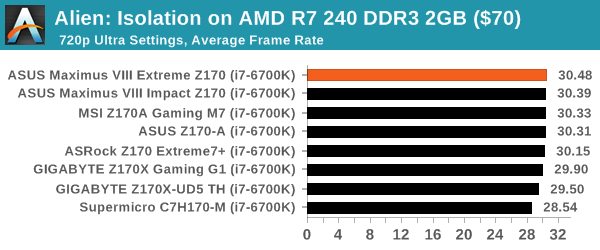
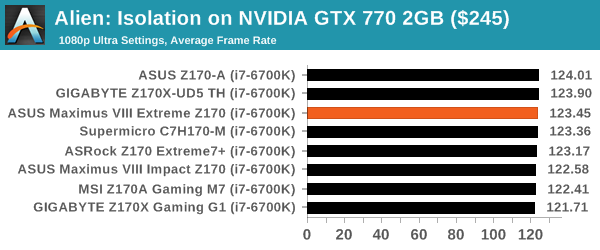
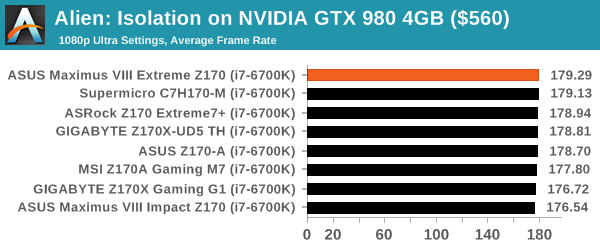
Total War: Attila
The Total War franchise moves on to Attila, another The Creative Assembly development, and is a stand-alone strategy title set in 395AD where the main story line lets the gamer take control of the leader of the Huns in order to conquer parts of the world. Graphically the game can render hundreds/thousands of units on screen at once, all with their individual actions and can put some of the big cards to task.
For low end graphics, we test at 720p with performance settings, recording the average frame rate. With mid and high range graphics, we test at 1080p with the quality setting. In both circumstances, unlimited video memory is enabled and the in-game scripted benchmark is used.
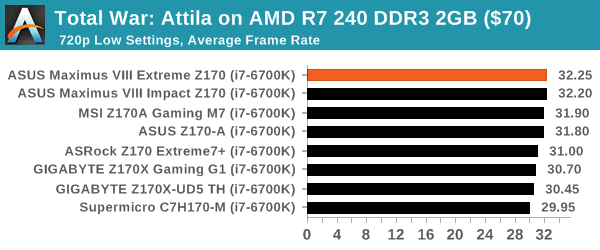
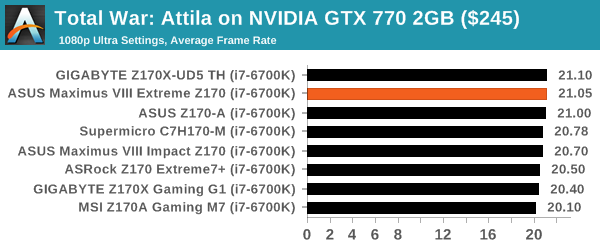
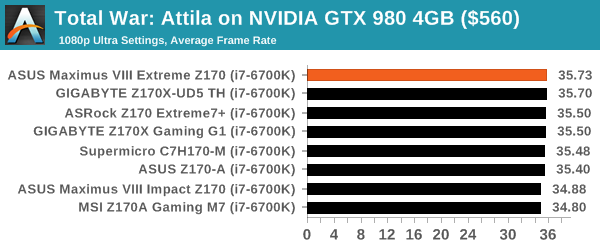
Grand Theft Auto V
The highly anticipated iteration of the Grand Theft Auto franchise finally hit the shelves on April 14th 2015, with both AMD and NVIDIA in tow to help optimize the title. GTA doesn’t provide graphical presets, but opens up the options to users and extends the boundaries by pushing even the hardest systems to the limit using Rockstar’s Advanced Game Engine. Whether the user is flying high in the mountains with long draw distances or dealing with assorted trash in the city, when cranked up to maximum it creates stunning visuals but hard work for both the CPU and the GPU.
For our test we have scripted a version of the in-game benchmark, relying only on the final part which combines a flight scene along with an in-city drive-by followed by a tanker explosion. For low end systems we test at 720p on the lowest settings, whereas mid and high end graphics play at 1080p with very high settings across the board. We record both the average frame rate and the percentage of frames under 60 FPS (16.6ms).
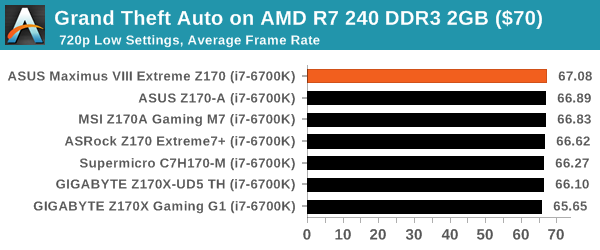
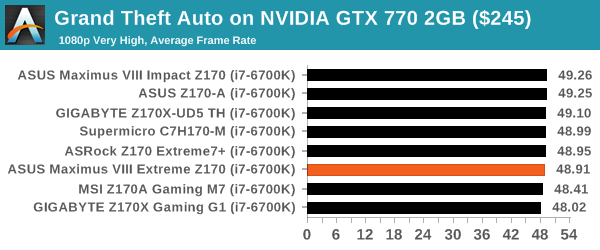

GRID: Autosport
No graphics tests are complete without some input from Codemasters and the EGO engine, which means for this round of testing we point towards GRID: Autosport, the next iteration in the GRID and racing genre. As with our previous racing testing, each update to the engine aims to add in effects, reflections, detail and realism, with Codemasters making ‘authenticity’ a main focal point for this version.
GRID’s benchmark mode is very flexible, and as a result we created a test race using a shortened version of the Red Bull Ring with twelve cars doing two laps. The car is focus starts last and is quite fast, but usually finishes second or third. For low end graphics we test at 1080p medium settings, whereas mid and high end graphics get the full 1080p maximum. Both the average and minimum frame rates are recorded.


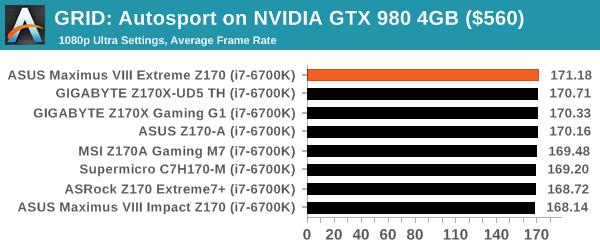
Middle-Earth: Shadow of Mordor
The final title in our testing is another battle of system performance with the open world action-adventure title, Shadow of Mordor. Produced by Monolith using the LithTech Jupiter EX engine and numerous detail add-ons, SoM goes for detail and complexity to a large extent, despite having to be cut down from the original plans. The main story itself was written by the same writer as Red Dead Redemption, and it received Zero Punctuation’s Game of The Year in 2014.
For testing purposes, SoM gives a dynamic screen resolution setting, allowing us to render at high resolutions that are then scaled down to the monitor. As a result, we get several tests using the in-game benchmark. For low end graphics we examine at 720p with low settings, whereas mid and high end graphics get 1080p Ultra. The top graphics test is also redone at 3840x2160, also with Ultra settings, and we also test two cards at 4K where possible.
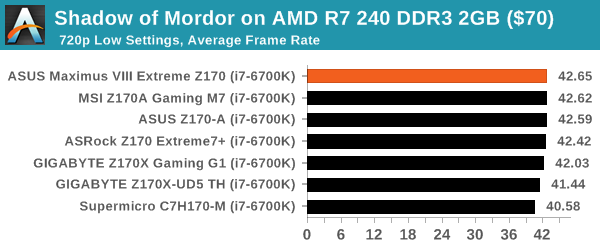
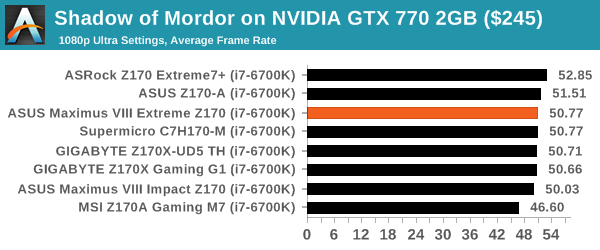

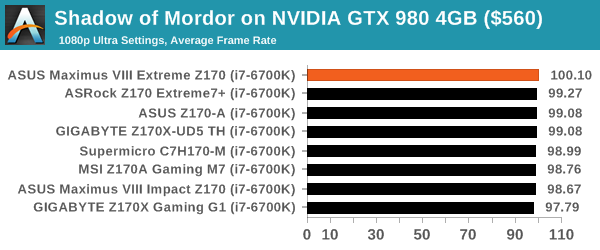
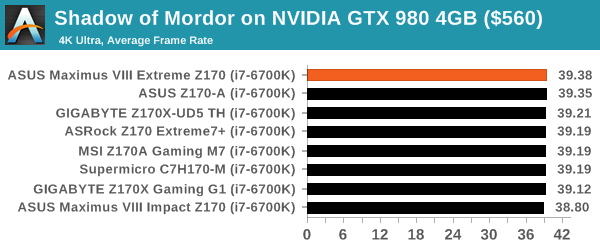















70 Comments
View All Comments
romrunning - Thursday, April 7, 2016 - link
Yes - Thunderbolt3Jon Tseng - Thursday, April 7, 2016 - link
Do these sort of mobos have particularly high end audio integrated? I could see an argument for paying more if you e.g. replaced a $100+ high end audio card.Ditto I guess for the wifi, given a lot of mobos don't seem to have this build in (something I never quite understood why).
arayoflight - Thursday, April 7, 2016 - link
The Z170 deluxe has the same 3x3 MiMo WiFi ac built in and costs much less. I don't think there are 3x3 MiMo cards you can buy. The best I could find was the 2x2 intel one for around 70$.Don't know about sound quality, but it should be good.
extide - Thursday, April 7, 2016 - link
You could read the review, but yes, they have pretty good onboard audio.saratoga4 - Thursday, April 7, 2016 - link
I really wish Anandtech would test the headphone out with maybe 32 ohm headphones rather than just the line out. I'd gladly pay extra for a board with good headphone out, but right now it is almost impossible to know which manufacturers are skimping and which are providing a quality output.DominionSeraph - Friday, April 8, 2016 - link
You can get an Audigy FX for $28. $25 from AmazonWarehouseDeals. (price goes up and down a tad -- I got mine for $22)The ALC898 it uses is no slouch.
extide - Friday, April 8, 2016 - link
That would be a downgrade.jptech7 - Friday, April 8, 2016 - link
For someone wanting better headphone out performance than a high end motherboard, I would not recommend an Audigy FX. The ALC 898 is a downgrade from either the Sabre in this Asus or the ALC1150 found on most good mobos, and for that price, I doubt its ability to drive high end headphones.The included Sabre chip on this Asus board is a quality component, but there are still likely some limitations to integrated audio solutions. For the few people desiring greater performance on their headphone out line, a USB or TOSLINK based dedicated headphone DAC & amp can be had. Decent ones start around $100 and scale up from there.
I would expect the only reason to buy additional equipment in this case would be if you need to provide greater than 2V RMS that the Sabre line driver can provide which is already quite decent.
DominionSeraph - Friday, April 8, 2016 - link
He didn't say he wanted more than a $500 motherboard, he said he wanted to know the performance. I pointed out that the performance is pretty meaningless since the Audigy FX exists. Why would you spend $500 on a motherboard when you can grab a $120 one and throw a $25 card in there that will not only be an upgrade over the ALC892 (or worse) that it will have, but has a headphone driver as well.There will be no discernible difference between an ALC898 and a 1150.
Murloc - Thursday, April 7, 2016 - link
if you care about audio you're exiting it on hdmi anyway, so it'd be a waste of money.